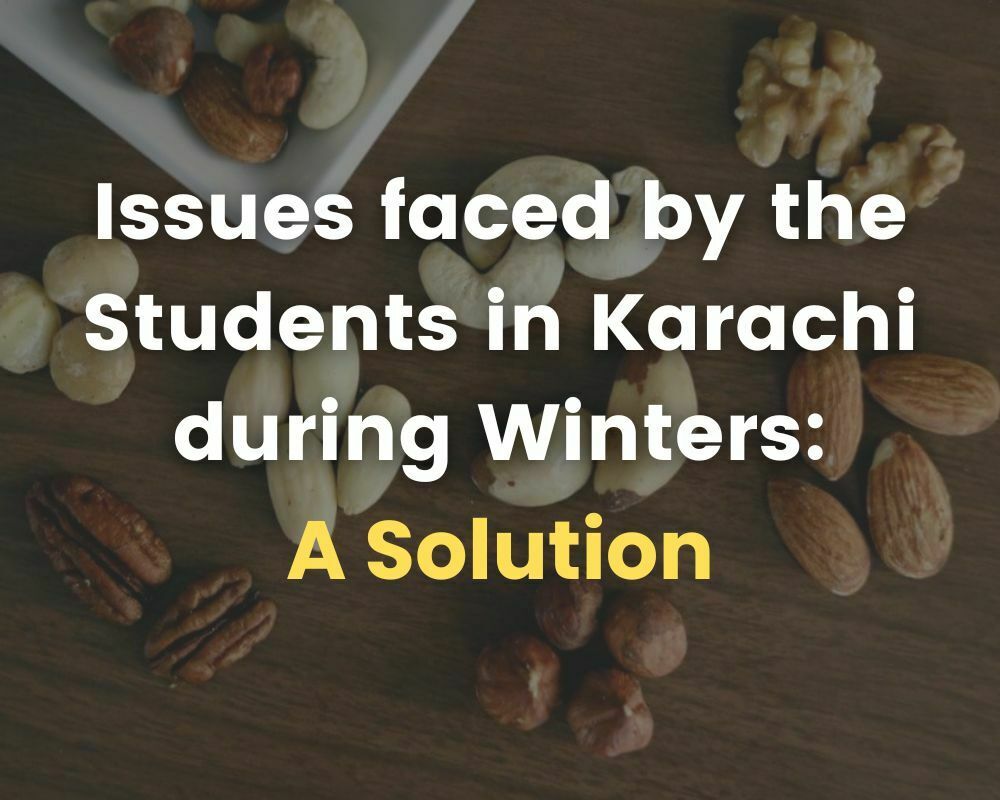Winter In Karachi: A Challenge For Students And The Solution

No, this post is not about the benefits dry fruits carry but why not treat your children by including some dry fruits in their lunchbox if you’re not already? Now let’s talk about the challenges students face in winter and what can be done to help cope with this recurring situation. Shall we?
Problem:
Karachi, Pakistan’s largest city, is noted for its fluctuating weather extremes. Summers in the city are hot, with temperatures reaching up to 40°C, while winters are warm to chilly, with temperatures ranging from 5°C to 20°C. However, weather extremes in the capital of Sindh have been shifting at an alarming rate in recent years.
Factors:
One of the major reasons behind these changing weather extremes is the phenomenon of climate change branching out from many other factors. A contributing factor to altering weather extremes in Karachi is the city’s growth and industry. Population growth and industrialization have resulted in increased air and water pollution, which is influencing the city’s climatic patterns. The presence of contaminants in the air causes the creation of smog, which traps heat and raises the temperature. Furthermore, deforestation in Karachi’s neighboring areas is contributing to shifting weather extremes. The loss of natural barriers that shelter the city from the strong heat is being caused by the removal of trees. Furthermore, the urban heat island effect is raising metropolitan temperatures as concrete and other man-made surfaces absorb and retain heat.
Impact on Health:
Cold weather may have a substantial influence on the health of Karachi schoolchildren, increasing the risk of colds and flu. Children who lack access to warm clothes and are exposed to low temperatures for extended periods of time may be more susceptible to respiratory illnesses. Extreme cold weather can also aggravate underlying health disorders like asthma, making it more difficult for children to manage them. Children who are not appropriately prepared for the cold weather are at a higher risk of frostbite or hypothermia as well.
Overall, exposure to cold weather can have a significant influence on the physical and emotional well-being of Karachi schoolchildren, thus impacting their education.
Difficulty in Focus:
Many schoolchildren in Karachi come from low-income households and may not have access to warm clothes throughout the winter season, such as jackets and gloves.
Due to a lack of appropriate clothes, young children may struggle to remain warm while traveling to and from school, resulting in pain and health risks.
Lack of warm clothes can also make it difficult for these youngsters to attend school, especially if they must walk long distances.
Children who do not have access to warm clothes may struggle to concentrate on their studies and may experience higher absenteeism as a result of the chilly temperatures.
Need of the Hour:
Every individual should is encouraged to act as per their abilities. Senior students should better look out for their juniors, help them, and pass on the awareness that they have. Parents already do their best to accommodate their loved ones with the warmest clothing they can afford, if there is any lack sensed by any individual, come forward as a responsible member of the community and share with your fellow peers.
Immediate measures that need to be taken by authorities:
Schools should ensure that classrooms are heated or insulated properly at a suitable temperature throughout the winter. A very good example has recently been witnessed by one of the most prestigious and disciplinary schools of the time. The school administration has circulated a notice permitting parents to send their children adequately; with gloves and mufflers and whatever they can manage without the need to worry about the color of the winter gear. This clearly shows the intent of the school holds no disparity over the well-being of their students.

School authorities should ensure that the transportation system is properly monitored.
The administration should ask for volunteer services for conducting Community organizations and efforts that offer warm clothing and other basics to school-aged children in need are urgently needed.
The government and private groups should collaborate to guarantee that all Karachi school children have access to warm clothes and other requirements throughout the winter.
Public awareness of the effects of cold weather on school-age children’s health and the significance of supplying them with warm clothing and other essentials should be raised.
Regular health checks and awareness campaigns about the impact of cold weather on health should be conducted in schools to ensure that children are protected from the cold weather.
Conclusion:
Overall, the Karachi winter season may bring a lot of obstacles for schoolchildren, many of which can have a detrimental influence on their education and overall well-being. Finally, shifting weather extremes in Karachi are the result of a confluence of causes such as climate change, urbanization, industrialization, deforestation, and the urban heat island effect. These factors are contributing to a rise in heatwaves and other extreme weather events in the city, which can have major effects on its citizens’ health and well-being. The absence of adequate attire for schoolchildren in Karachi is something that shows the need for community activities and initiatives.




